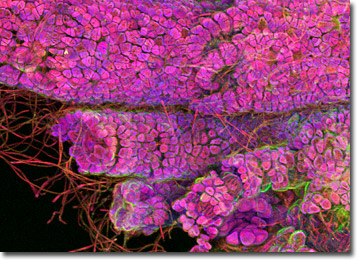 |
 |
 |
|
||||||||||||||||||||||||
 | ||||||||||||||||||||||||
 | ||||||||||||||||||||||||
 | ||||||||||||||||||||||||
Confocal Microscopy Image Gallery
Plant Tissue Autofluorescence Gallery
Red Seaweed
Seaweeds are multicellular marine algae popularly named for their seeming similarity to terrestrial weed species. The fronds and the holdfasts that anchor many of the more advanced types of seaweed in place at first appear similar to the leaves and roots of some land plants, but do not carry out all of the same functions.

Seaweeds occur in several different colors, including red, brown, and green, and a wide range of sizes, from only a few inches to more than one hundred feet long. Despite their disparaging name, which is suggestive that the algae are undesirable or troublesome, many seaweeds are highly useful to humans. Certain species are extremely nutritious sources of food, while others have been utilized in such diverse applications as upholstering, curing leather, and the production of cosmetics, paper, and pharmaceuticals.
Red seaweeds are members of the division Rhodophyta that obtain their crimson hue from phycocyanin and phycoerythrin pigments, water soluble fluorescent proteins that mask the green coloration of chlorophyll. These pigments enable rhodophytes to absorb energy in parts of the spectrum that are not utilized well by chlorophyll. As a result, red seaweeds are able to survive at deeper depths than other seaweeds. Some of the most familiar red seaweeds include dulse (Rhodymenia palmata) and nori (Porphyra species), both of which are commonly eaten in certain parts of the world. Important extracts utilized as gelling and thickening agents can be obtained from these and other red seaweed species.
Contributing Authors
Nathan S. Claxton, Shannon H. Neaves, and Michael W. Davidson - National High Magnetic Field Laboratory, 1800 East Paul Dirac Dr., The Florida State University, Tallahassee, Florida, 32310.
